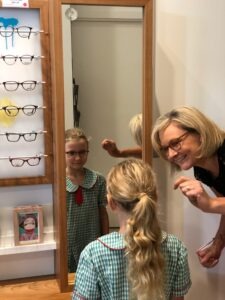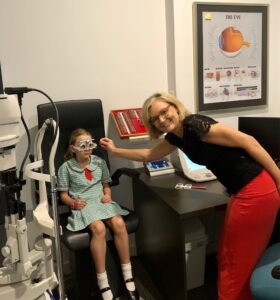What is Vision Therapy for kids?

Unlike eyeglasses and contact lenses that compensate for vision problems, or eye surgery that alters the anatomy of the eye or surrounding muscles, vision therapy aims to “teach” the visual system to correct itself.
Vision therapy is like physical therapy for the entire visual system. Vision therapy can include the use of lenses, prisms, filters and other devices, such as balance boards & metronomes, can play an important role in a customised vision therapy program. Overall, the goal of optometric vision therapy exercises should be to treat vision problems that might not be treated successfully with eyeglasses, contact lenses and/or surgery alone, and to help people achieve clear, comfortable binocular vision.
Many studies have shown that one benefit from vision therapy can correct vision problems that interfere with efficient reading among school children. It also can help reduce digital eye strain and other symptoms of computer vision syndrome experienced by many children and adults. See below for more on conditions treated with vision therapy.

Problems vision therapy can correct:
Vision problems being treated with vision therapy include the following:
- Amblyopia: Also called “lazy eye,” is a vision development problem in which an eye fails to attain normal visual acuity, usually due to binocular vision problems.
- Strabismus: The success of vision therapy for strabismus depends on the direction, magnitude and frequency of the eye turn. Vision trianing has been proven effective for treating an intermittent form of strabismus called convergence insufficiency, which is a failure to keep the eyes properly aligned when reading despite appropriate alignment when looking at distant objects.
- Other binocular vision problems: Subtle eye alignment problems called phorias that may not produce a visible eye turn but still can cause eye strain and eye fatigue when reading also can be minimized or corrected with vision training.
- Eye movement disorders: Studies have shown vision therapy can improve the accuracy of eye movements used during reading and other close-up work.
- Accommodative (focusing) disorders: Other research shows near-far focusing skills can be improved with vision training.
- Other problems: Other vision problems for which vision therapy may be effective include visual-perceptual disorders, vision problems associated with developmental disabilities and vision problems associated with acquired brain injury (such as from a stroke).
If you think your child has a vision or visual problem that may be affecting their performance in school or sports, the first step is to schedule a routine eye exam to rule out nearsightedness, farsightedness and/or astigmatism. At Beckenham Opotmetrist, our optometrist are able to carry out the necessary examiniations and asaign apporpiate vision training exercises. Make sure you are checking in with both your child and their classroom teachers to make sure their vision is not hindering their learing and development.
Why are children’s eye exams important?
Eyesight is the most important of our senses and provides 80% of the information used for learning and education, as well as coordinating our movement in and around our surrounding environment. Children require good eyesight and good eye coordination so they can reach all their developmental and educational milestones.
Why is a comprehensive eye examination recommended for your back to school checklist?
Because 80% of learning comes through eyesight, it is important for the child’s vision and eye coordination to be optimised so there is no detrimental effect on learning and school performance. The ideal time to have the child examined is at the beginning of each school year to ensure that their visual development is proceeding normally, and for the optometrist to treat any underlying conditions that may impact learning. This is why it is critical to add an eye exam to your back to school checklist.
Children’s eyes continue to develop until the late teens and early 20’s, and sometimes large changes in vision can occur within a short space of time. Depending on the type of eye condition present, your optometrist will advise the best timing for the next eye exam as some children require more frequent visits during the school year.







